Introduction
In today’s rapidly evolving business landscape, organizations are constantly seeking ways to enhance efficiency and optimize operations. Robotic Process Automation (RPA) has emerged as a transformative solution, automating repetitive and rule-based tasks to free up human resources for more strategic activities. This article delves into the myriad benefits of RPA, showcasing its potential to significantly boost productivity, accuracy, and cost-effectiveness.
From assessing processes ripe for automation to selecting the right tools and ensuring seamless integration, each step of the RPA journey is explored in detail. Furthermore, key insights into overcoming implementation challenges and adopting best practices for successful deployment are provided. By embracing RPA, businesses can not only streamline workflows but also achieve a competitive edge in an increasingly digital world.
Benefits of RPA in Business
Robotic Process Automation (RPA) significantly boosts operational efficiency by automating repetitive and rule-based tasks, such as data entry, data extraction, and document processing. These software robots, or ‘bots,’ mimic human actions on a computer system, thereby reducing human error and allowing employees to focus on higher-value activities. This shift not only enhances productivity but also improves accuracy and drives substantial cost savings.
In terms of impact, Forrester’s study on the Economic Impact of Microsoft 365 Copilot highlights a remarkable return on investment ranging from 132% to 353% over three years for businesses that adopt RPA and intelligent automation. The study further reveals a 73% revenue growth of overall net present value (NPV) benefit and a 5.4% compound annual growth rate (CAGR) for businesses leveraging these technologies.
Furthermore, RPA optimizes workflows, ensuring enhanced adherence to regulations by keeping comprehensive records of all automated activities. For example, Specsavers, a leading optical retailer, has utilized RPA to manage its complex global supply chain, which includes over 2,000 stores and a variety of medical devices. This implementation has enabled Specsavers to efficiently transfer information between older, non-API-compatible machines and modern systems, thus overcoming significant operational challenges.
RPA also enhances customer satisfaction by speeding up response times and ensuring consistent and accurate information delivery. In an age where customer experience is paramount, these improvements can lead to increased loyalty and retention, further contributing to a company’s competitive edge.
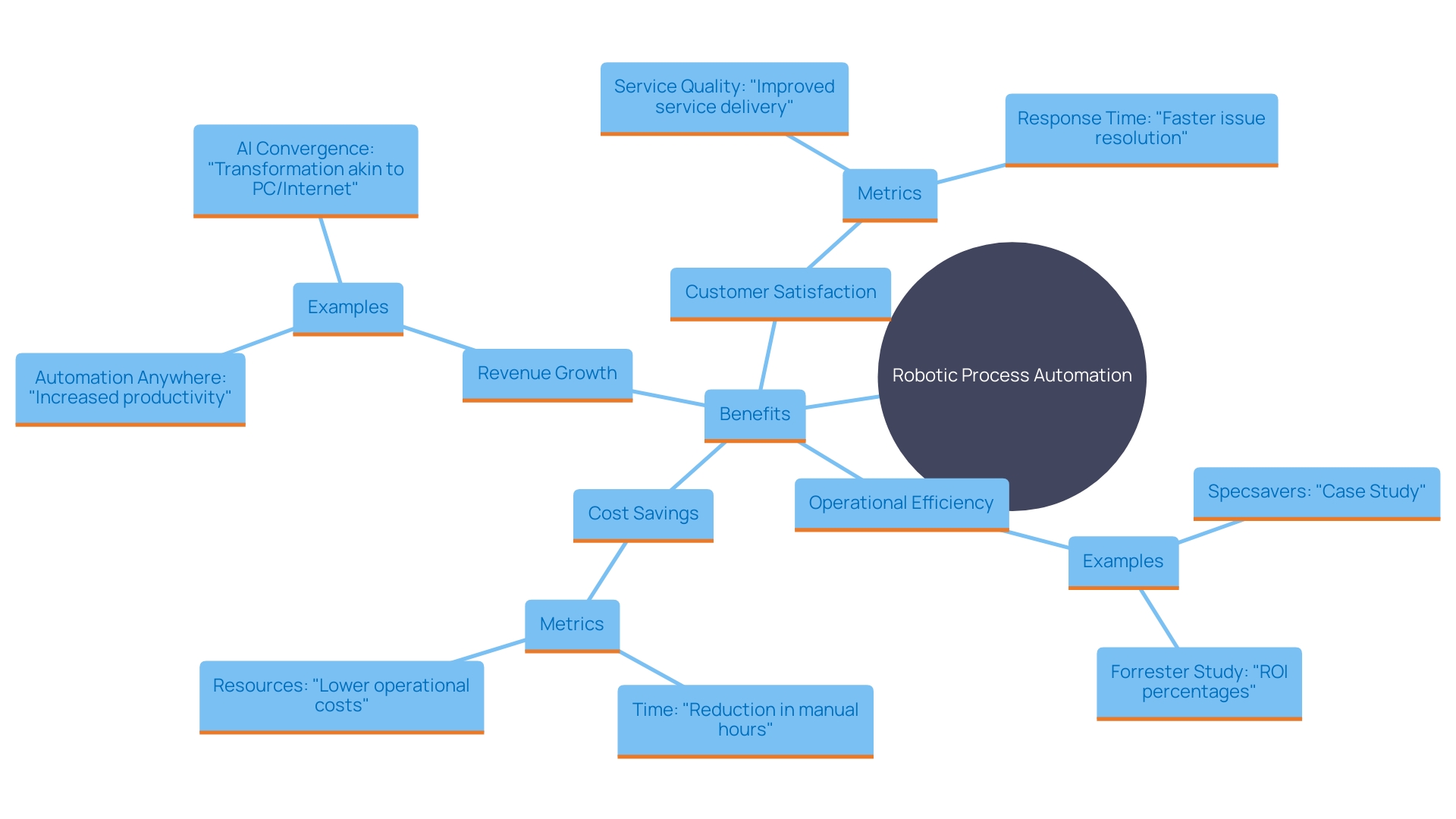
Step 1: Assess and Identify Processes for Automation
Begin by thoroughly evaluating your existing business operations, concentrating on activities that are repetitive, rule-based, and time-consuming, as these are perfect for automation. This evaluation should include the three critical steps of digitization, digitalization, and digital transformation. ‘Digitization entails turning physical documents into digital form, digitalization utilizes this data to enhance methods, and digital transformation employs these tools to create value and reshape operations.’. Engage with team members to gather their insights on inefficiencies and bottlenecks within workflows, ensuring a comprehensive understanding of areas needing improvement. By placing technology at the center of execution, you can free up human resources to focus on high-value tasks, ultimately enhancing overall operational efficiency.
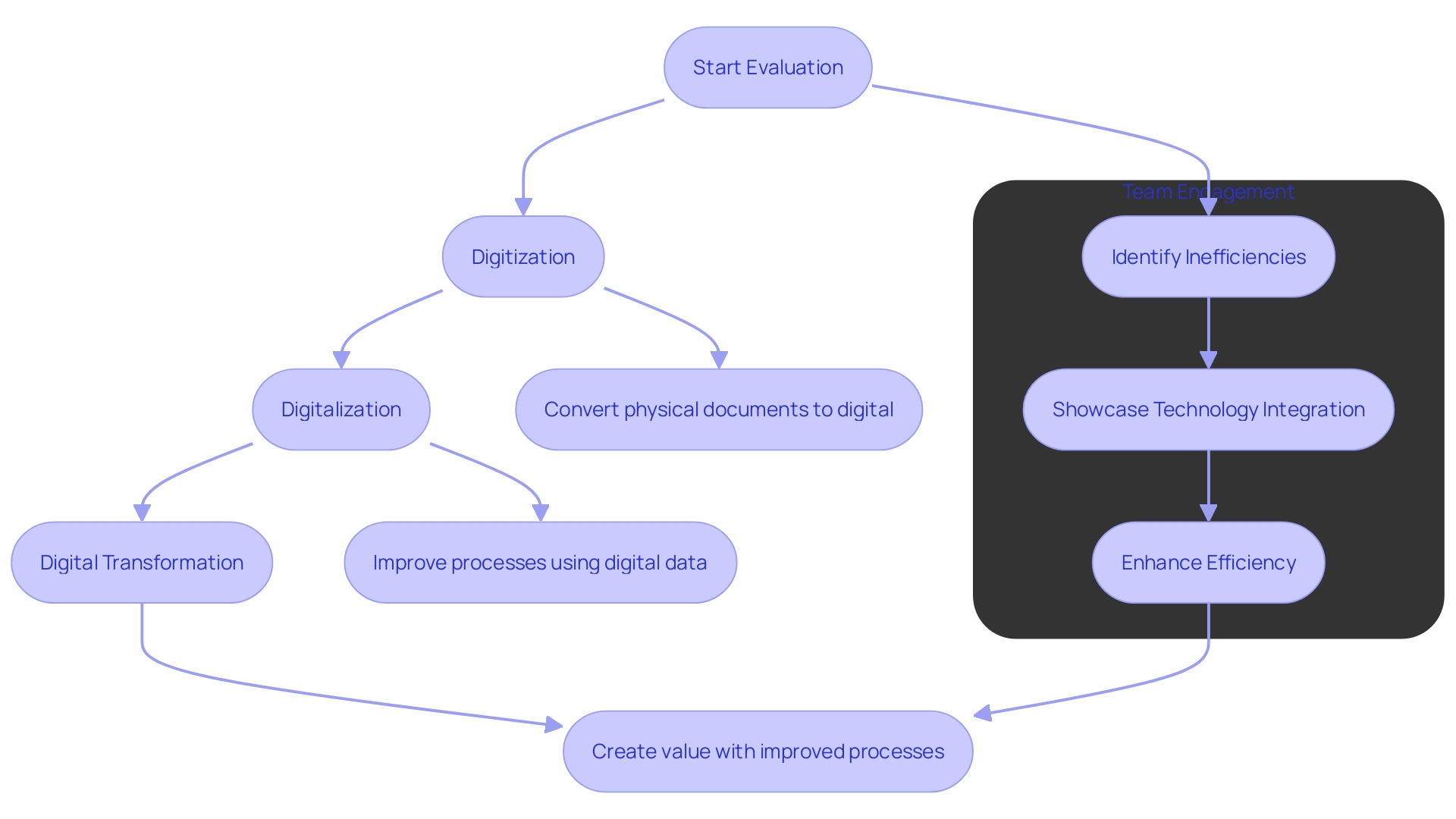
Step 2: Define Objectives and Scope of RPA Implementation
Defining the objectives for implementing Robotic Process Automation (RPA) is essential for its success. Start by identifying clear goals, such as reducing processing times, minimizing errors, or improving service delivery. Determine the scope by identifying which activities will benefit most from automation. Assess the frequency of these processes, the potential monetary value they offer, and whether they experience peak demand periods. For instance, the finance department of Mass General Brigham hospital system in Boston faced significant bottlenecks in tracking healthcare providers. By establishing an automation team, they optimized workflows and developed a tool that simplified information gathering, dramatically enhancing efficiency. This approach highlights the importance of strategic alignment and the need to consider both structured data and the sensitivity of information involved. Ultimately, a well-defined objective and scope ensure that RPA initiatives align with organizational goals and deliver measurable benefits.
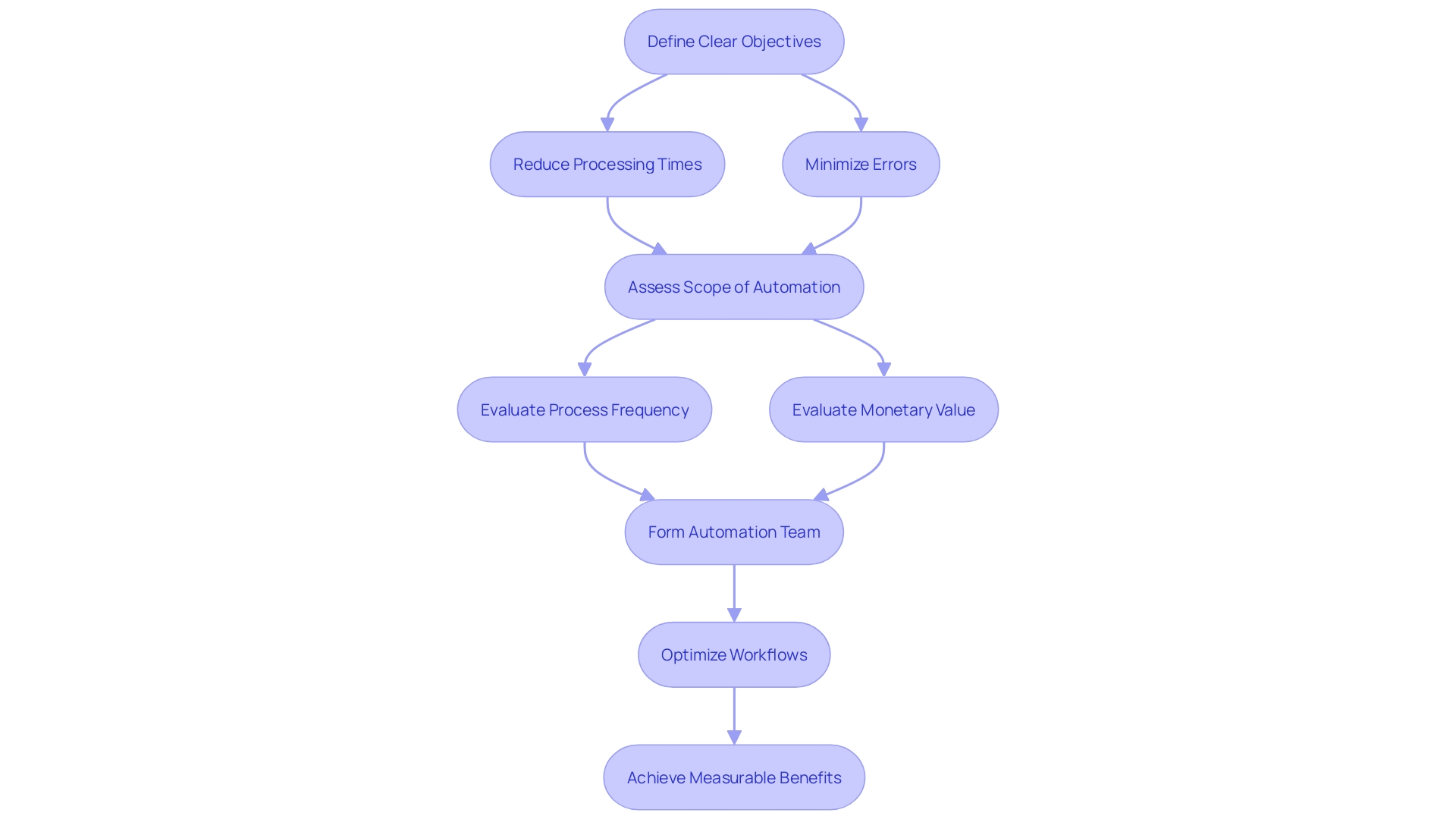
Step 3: Select the Right RPA Tool and Vendor
Selecting the right RPA tool requires thorough research and evaluation of the available options in the market. Key factors to consider include ease of use, scalability, vendor support, and integration capabilities with existing systems. For instance, automation solutions should be tailored to the type of user and the complexity of the tasks they will automate. Whether a no-code, low-code, or high-code solution is required depends on whether the users are developers or non-technical staff.
Additionally, the choice of vendor should align with your business needs and provide robust implementation support. As highlighted by Robotic Process Automation experts, automation is not a ‘set it and forget it’ solution; continuous monitoring and management are essential. Therefore, selecting a vendor that offers comprehensive support and frequent updates is crucial for sustained success.
Consider the example of companies undergoing digital transformation. By prioritizing end-to-end execution, these organizations have significantly improved efficiency and productivity. Emulating such best practices can lead to higher operational efficiency and better alignment with strategic goals.
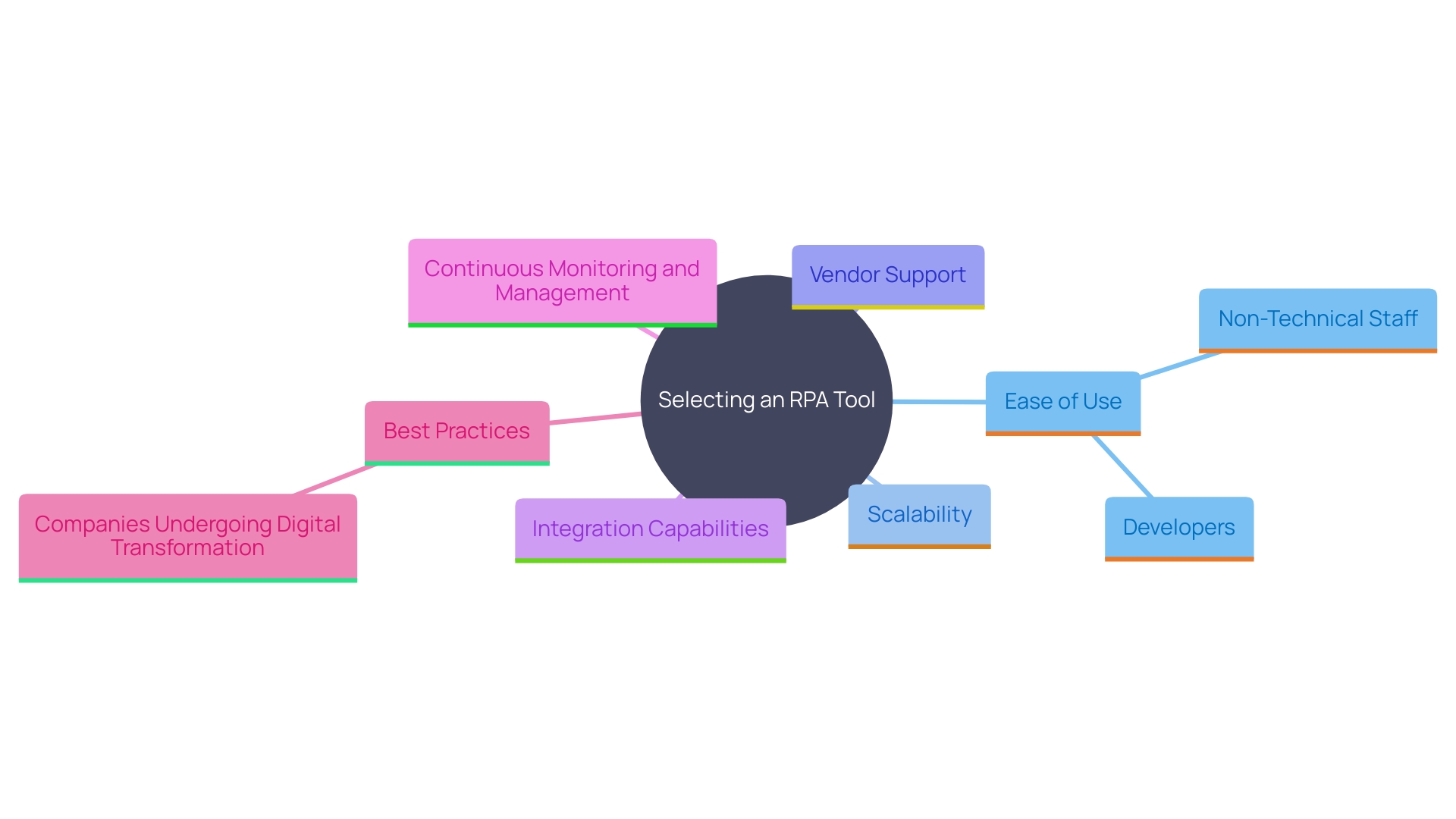
Step 4: Process Analysis and Design
Carrying out a comprehensive examination of the recognized procedures is essential. Begin by mapping out current workflows to visualize the existing state. This step uncovers inefficiencies and redundancies, providing a clear picture of where improvements are needed. For instance, in healthcare technology adoption, an initial assessment by the Digital Service Team ensures that the requested technology is both secure and compliant. This approach avoids redundancy, as seen when existing functionalities were discovered to be underutilized within the NHS.
Next, create optimized workflows tailored for RPA automation. This involves rethinking workflows to maximize efficiency and effectiveness. By adopting a lean methodology, similar to those used in garment manufacturing, you can streamline production lines and integrate automation seamlessly. This holistic view boosts overall efficiency, reduces costs, and enhances productivity.
Rivian’s commitment to achieving net-zero emissions by 2040 exemplifies the significance of sustainable practices. Their method of reducing waste at every phase, from raw material supply to production, underscores the necessity for sustainable and efficient system designs.
Implementing RPA requires not only technical adjustments but also a cultural shift within the organization. Engaging all stakeholders, from top management to front-line employees, is crucial. Drawing on human-centered automation principles ensures that user needs and preferences are prioritized, making the transition to RPA smoother and more effective.
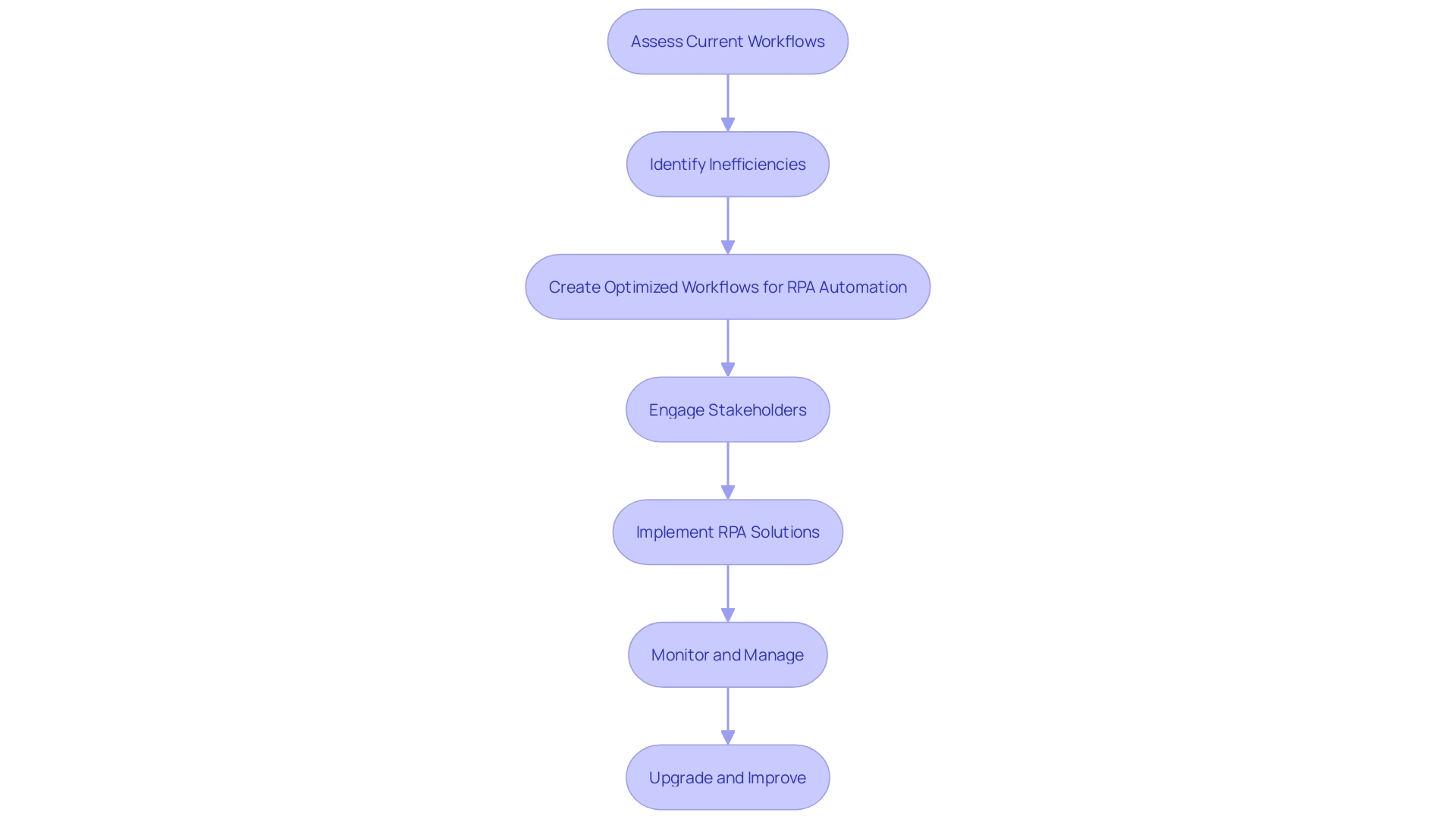
Step 5: Bot Development and Testing
Developing automation bots requires a meticulous approach to ensure they operate flawlessly and adapt to various scenarios. Start by building the bots in accordance with the established protocols, utilizing advanced technologies and methods to improve their functionalities. Rigorous testing is paramount; it plays a critical role in validating that the bots meet specified requirements, function correctly, and provide a seamless user experience across diverse scenarios and edge cases.
The importance of software testing in these projects cannot be overstated. Effective testing identifies and rectifies defects, ensures compliance with standards, and delivers reliable and high-performing bots. This is especially crucial in large-scale implementations where the complexity and scale of the software involve multiple teams, extensive codebases, and numerous integrations with third-party systems. As highlighted by experts, traditional testing approaches often fall short in such complex environments, necessitating innovative testing strategies to keep pace with rapid development and deployment cycles.
Moreover, the deployment phase should only commence once the bots have demonstrated their reliability and efficiency through comprehensive testing. By incorporating thorough validation methods, organizations can be confident that their automation solutions will perform as expected, thereby optimizing operational efficiency and productivity.
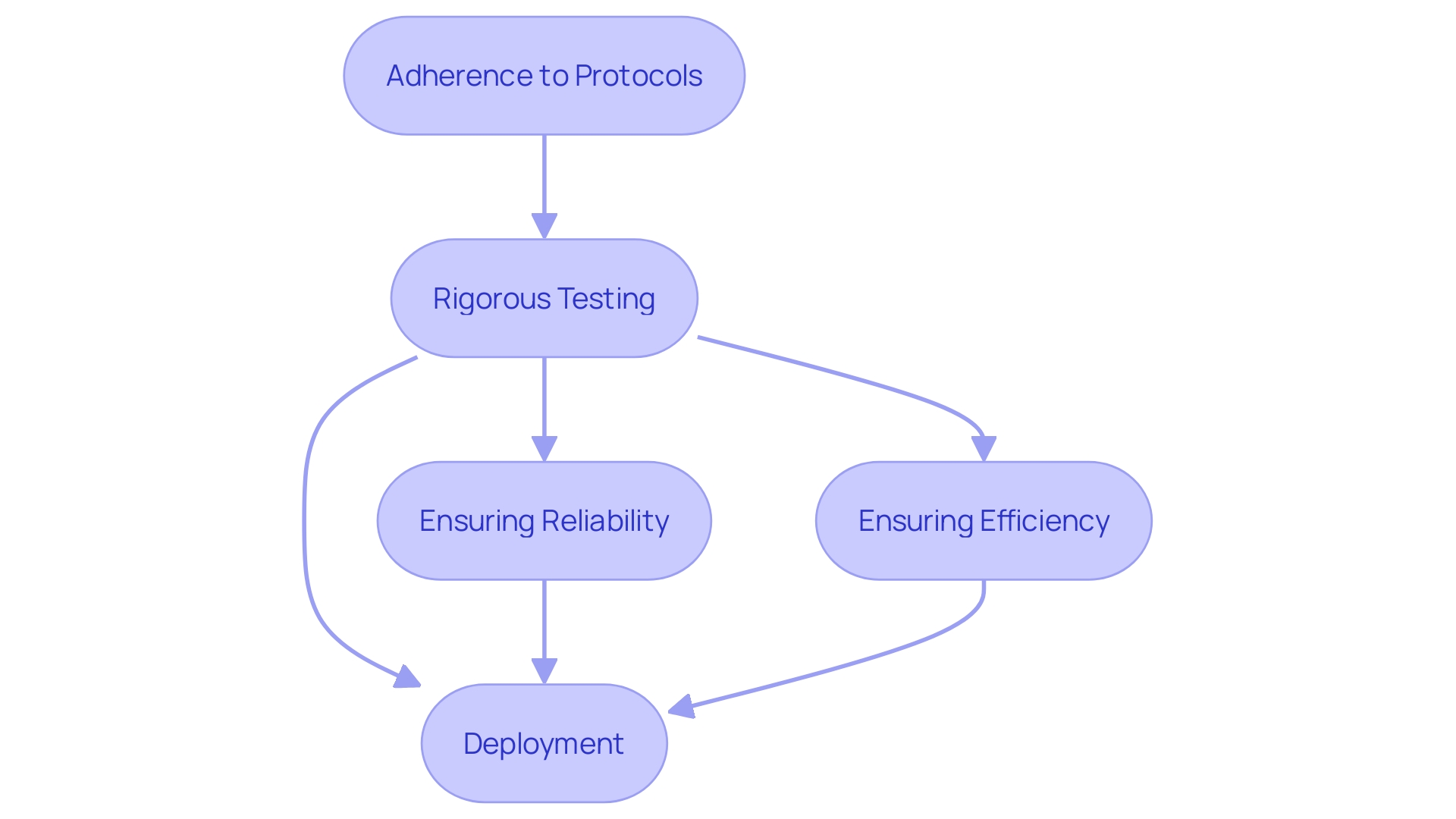
Step 6: Integration with Existing Systems
For a successful RPA implementation, it is essential to ensure that the solution integrates seamlessly with your existing systems and applications. This often involves configuring APIs or utilizing connectors. API integration plays a crucial role in sustaining information flow and operational continuity, which is essential for the effectiveness of automated systems. According to Professor Marshall Van Alstyne’s research, companies leveraging APIs have experienced a 12.9% growth in market capitalization compared to those that have not, underscoring the importance of API integration in driving financial performance and enterprise value.
Lindy, an AI assistant designed for tasks like medical scribing and customer support, faced a significant challenge in integrating a large network of applications and services. Without proper integration, the rollout of their AI solutions would have been delayed by up to a year, emphasizing the critical nature of seamless integration in operational timelines.
Automation has long been a cornerstone of business innovation, but it requires continuous monitoring, management, and upgrades to achieve stability and efficiency. As Robotic Process Automation (RPA) becomes more prevalent, the strategic use of APIs to streamline processes will become even more essential, allowing organizations to focus on high-value tasks while maintaining robust operational workflows.

Step 7: Security and Compliance Measures
To effectively safeguard sensitive information and ensure adherence to regulations, organizations must implement comprehensive security measures. Begin by establishing robust access controls to regulate who can view or use specific resources within your system. The Essentials of Access Control report highlights that access control is a fundamental component of physical security strategy, as supported by a survey of over 1,000 security practitioners. Utilizing advanced access control technologies and stringent policies can significantly reduce unauthorized access risks.
Along with access controls, encryption is essential for protecting information. Encrypting data both at rest and in transit ensures that sensitive information remains secure even if it falls into the wrong hands. This is particularly crucial as the convergence of Operational Technology (OT) and Information Technology (IT) introduces new vulnerabilities. As noted by Fouad Khalil, the rise in cyber threats like ransomware and phishing attacks makes robust security measures essential, especially in sectors transitioning to automated systems.
Moreover, implementing audit trails to monitor bot activities provides a transparent and accountable record of all operations, helping to identify and address any anomalies swiftly. Automated systems and their security protocols must not be an afterthought but a foundational aspect of any implementation, ensuring that both digital and physical assets are protected from evolving threats.
By integrating these measures—access controls, encryption, and audit trails—organizations can create a secure environment that not only meets regulatory requirements but also instills confidence in their operations.
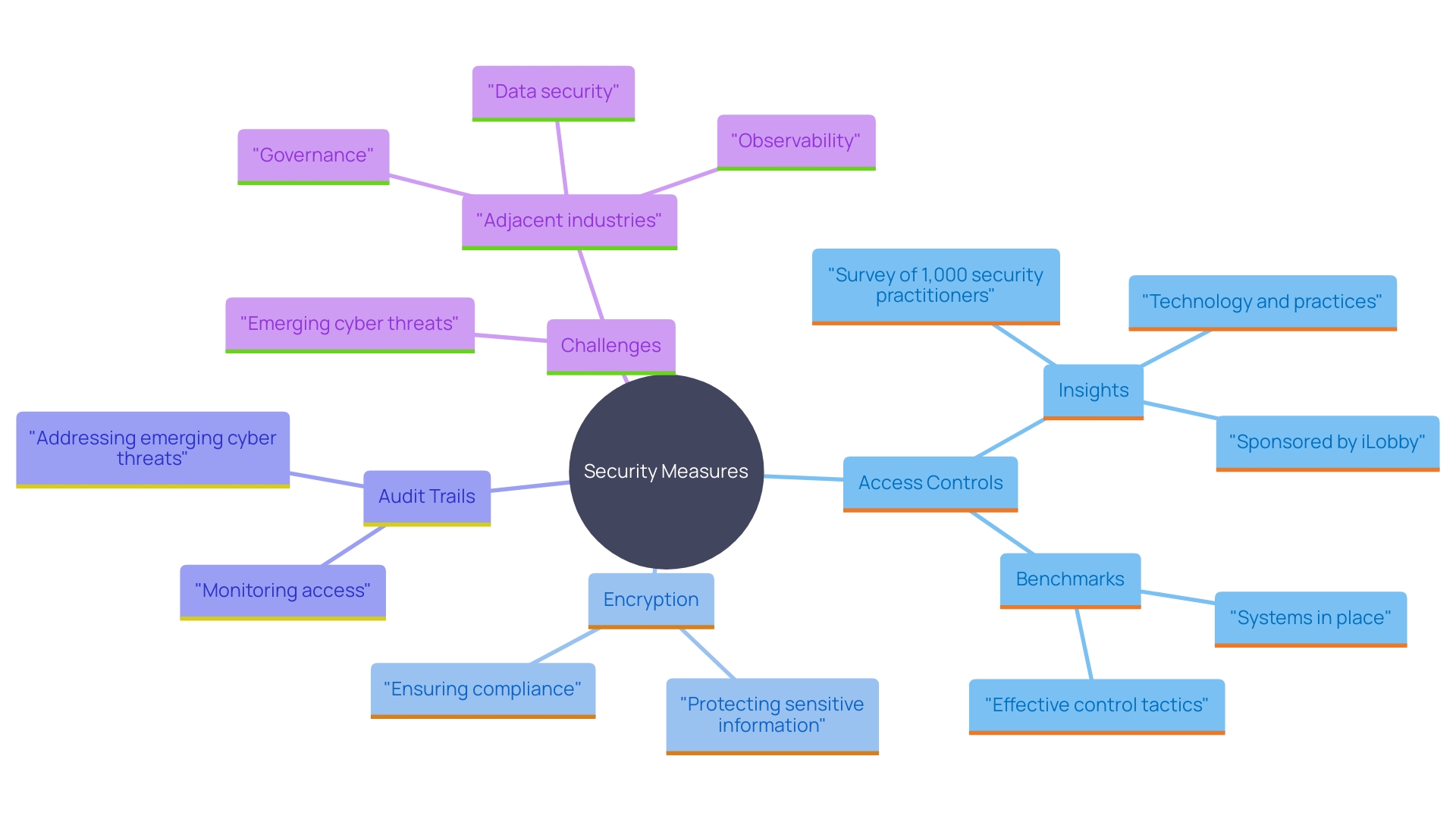
Step 8: Training and Change Management
Effective training is essential for employees who will engage with RPA tools. Address their concerns regarding job displacement by emphasizing the benefits of RPA, such as increased efficiency and reduced repetitive tasks. Highlight that RPA can enhance their roles rather than replace them. To foster a culture that embraces change and innovation, ensure that your organization has a strong digital core. Platforms like Salesforce, Microsoft, and NetSuite can provide a robust foundation for digital transformation, supporting seamless customer service and internal collaboration.
It’s important to understand that the odds of failure in digital transformation can be high, with some estimates suggesting a failure rate of over 70%. However, success is attainable by structuring your approach around principles such as anticipation, reflexivity, inclusion, and responsiveness. By aligning your innovation processes with these principles, you can effectively manage the societal and ethical implications of new advancements.
Furthermore, the extensive accessibility of AI and cloud computing resources has considerably reduced the obstacles to embracing advanced innovations. This accessibility enables businesses to utilize the strength of information and analytics, changing software development from a specialist support service to a strategic capability at the core of the business.
To ensure a smooth transition, it’s crucial to prepare your workforce for the changes AI and automation bring. This includes navigating the complex interplay between technological advancements and human roles, addressing concerns about employment displacement, and fostering skill development. By adopting a consistent approach to vetting new technologies and involving employees in the procedure, businesses can profit from innovation while deploying technologies responsibly.
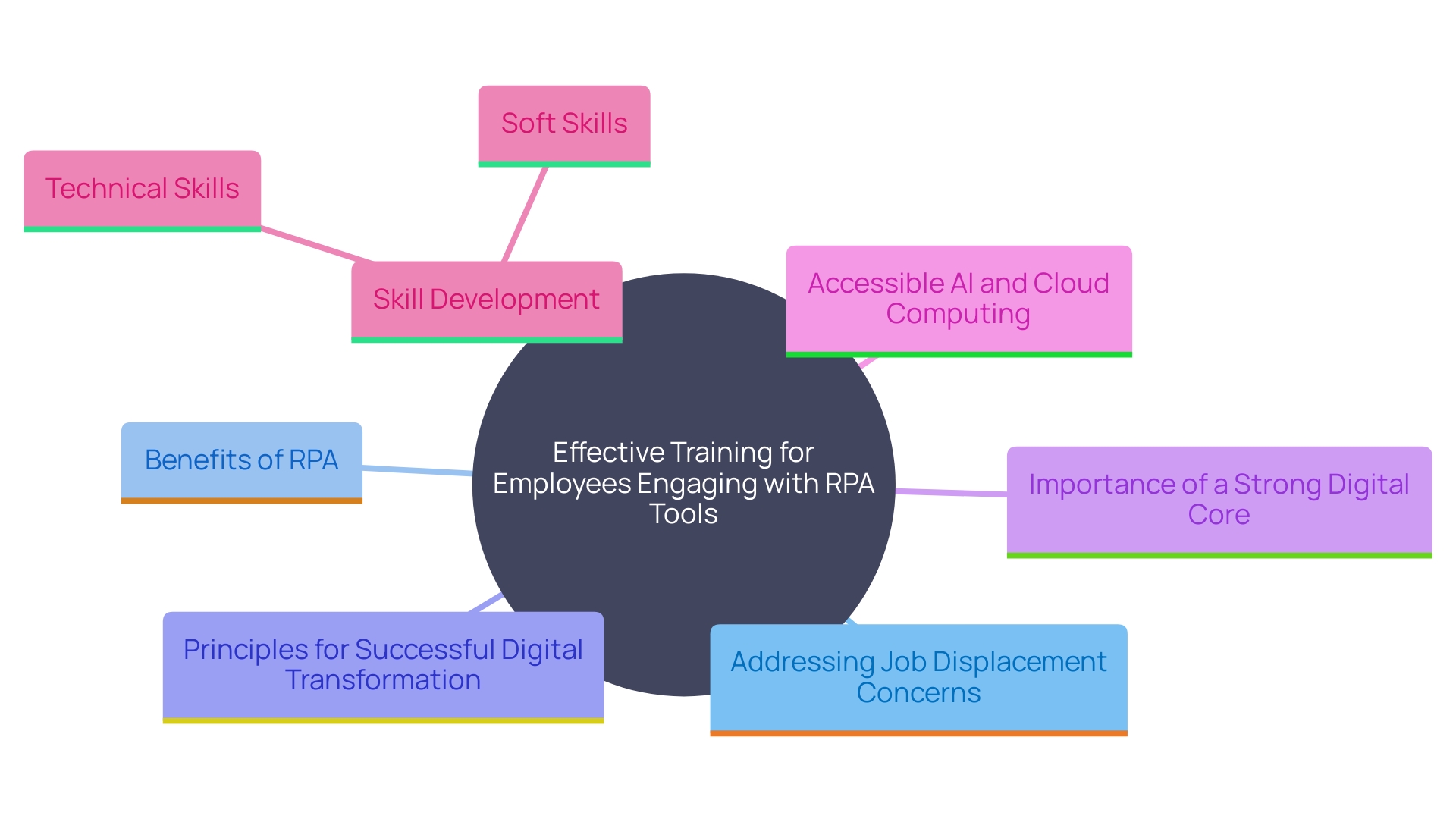
Step 9: Pilot Deployment and Evaluation
Initiate a pilot program to deploy RPA within a controlled setting to evaluate its impact comprehensively. Start by converting current information and documents to depict the tangible operations precisely. This digitization is crucial, as it lays the groundwork for further digitalization and transformation efforts. By changing methods and leveraging enhanced data collection and analysis, organizations can improve information sharing and decision-making frameworks.
Monitor the performance of the bots closely and gather feedback from users to understand their experiences and identify any issues. This step is essential to ensure that the system is placed at the center of end-to-end process execution, allowing human workers to focus on high-value tasks.
Assess the effectiveness of the automation against the established objectives. This involves determining whether the deployment has achieved the desired improvements in efficiency and productivity. According to a recent study on digital transformation initiatives, key learnings and outcomes from similar implementations can provide valuable insights.
By following these steps, organizations can navigate the complexities of RPA deployment, ensuring that the system adds value and aligns with their strategic goals.
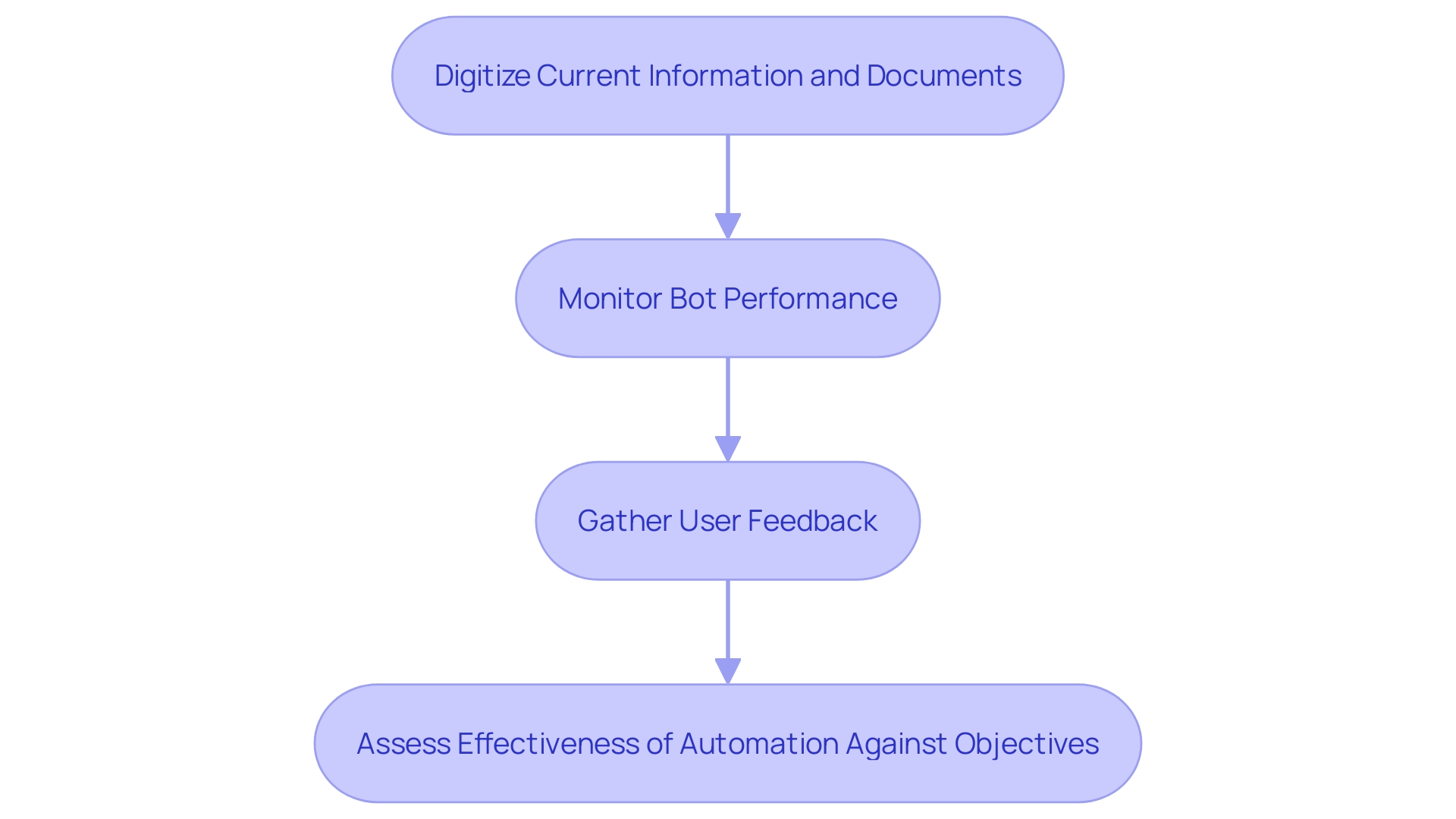
Step 10: Scaling Up and Continuous Improvement
After a successful pilot, it’s essential to strategize for a comprehensive RPA deployment across the organization. Continuous feedback collection and performance metric analysis are crucial for identifying further improvement and optimization areas. For instance, the finance department at Mass General Brigham hospital faced inefficiencies in tracking healthcare providers. By forming an automation team and integrating RPA, they streamlined data collection and processing, significantly enhancing workflow efficiency. This example underscores the importance of ongoing evaluation and feedback in achieving sustained operational excellence.
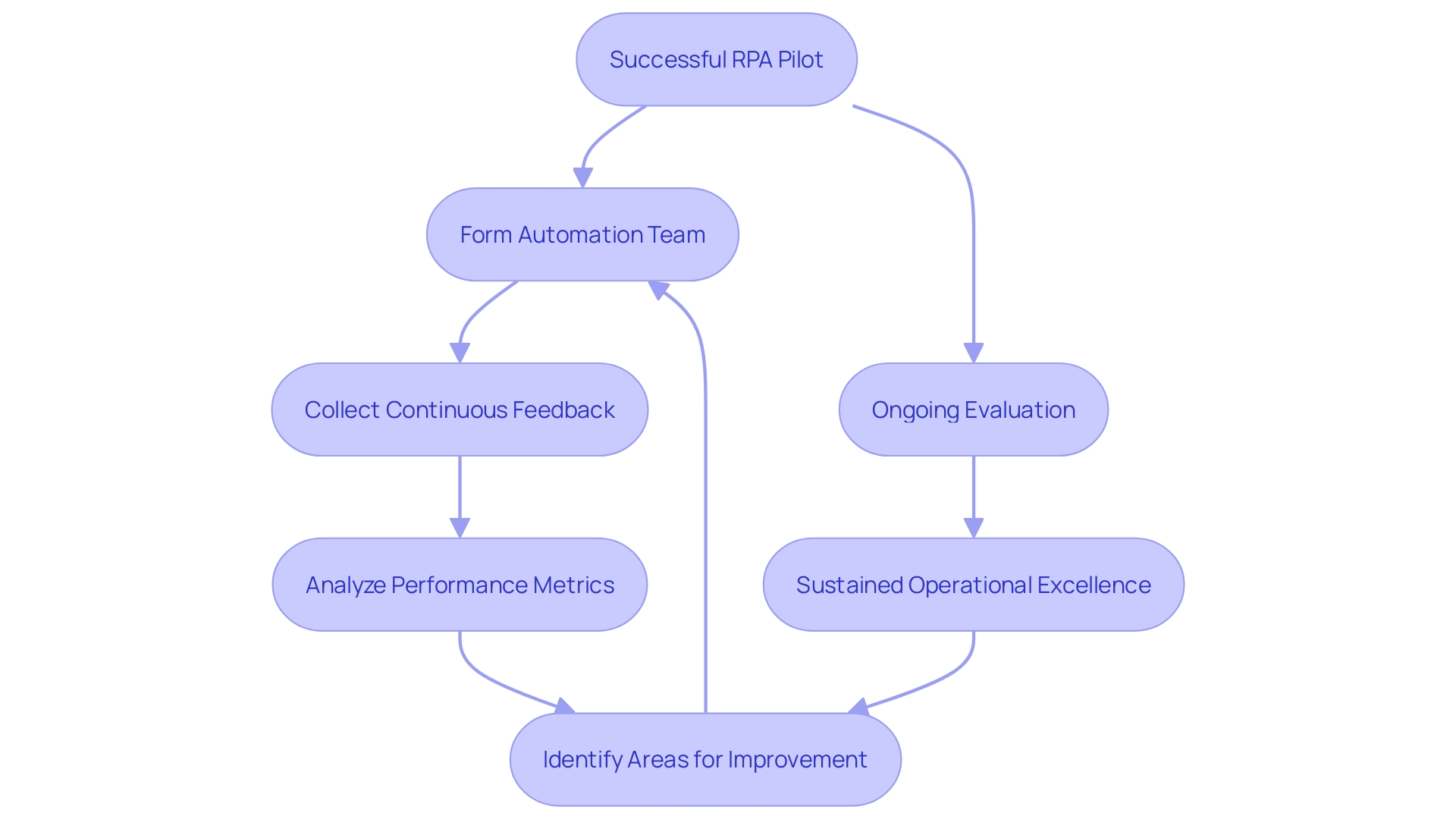
Step 11: Monitoring and Maintenance
Implementing a robust monitoring system for RPA bots is crucial to ensure their optimal performance. Regular maintenance and proactive problem-solving are necessary to address any issues promptly, thus maintaining the bots’ efficiency over time. As automation continues to evolve, it’s essential to recognize that it still requires human oversight to ensure stability and effectiveness. For instance, monitoring and management have always been essential to the success of automated systems, including AI. This partnership between humans and technology is vital for achieving consistent operational performance.
A case in point is the Oleoducto de Crudos Pesados (OCP) Ecuador, which underscores the importance of reliable maintenance practices. By ensuring that spare assets were available and operational, the company maintained efficiency even when operating at reduced capacity. Similarly, leveraging modern tools to receive early warnings and adjust processes can significantly minimize interruptions and prevent failures, thus enhancing overall asset performance.
Furthermore, the incorporation of information management practices is essential in this context. As Clive Humby famously said, ‘Data is the new oil.’ Ensuring the quality of data before analysis or implementation is imperative to avoid the ‘garbage in, garbage out’ scenario. This approach not only supports the monitoring of RPA bots but also aligns with broader business architecture methodologies that drive successful digital transformations.
In the realm of RPA, regular updates and compliance checks are also necessary. For instance, in the healthcare field, digital tools undergo rigorous assessments to ensure they are secure, appropriate, and compliant with necessary approvals. This meticulous approach helps in identifying pre-existing solutions and avoiding redundancy, ultimately contributing to the seamless adoption and maintenance of new technologies.
In summary, the continuous monitoring and maintenance of RPA bots, backed by reliable data and compliance checks, are crucial for sustaining their efficiency and achieving long-term operational success.
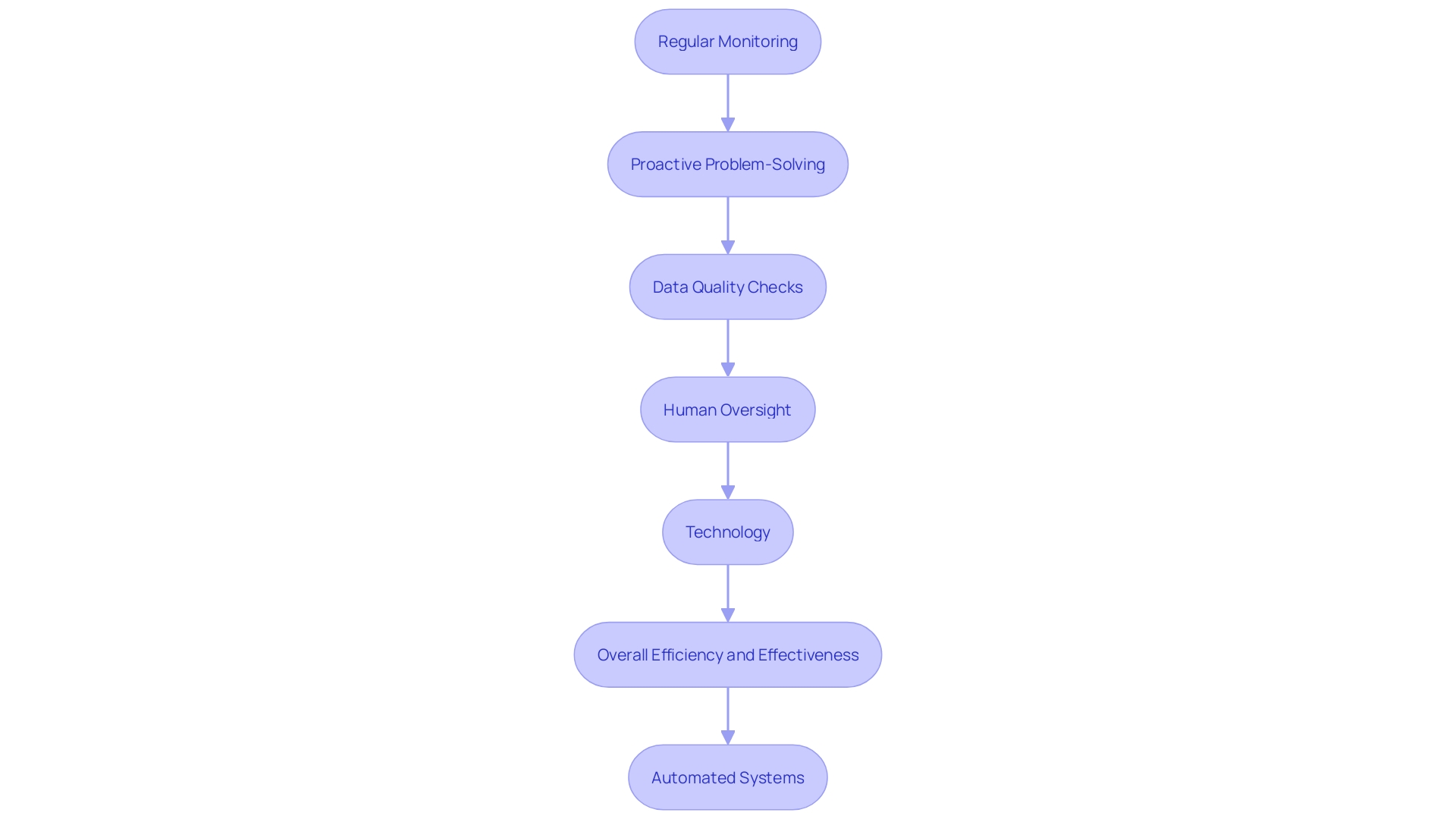
Common Challenges in RPA Implementation
Navigating the hurdles of digital transformation, such as resistance to change, complexities of operations, and integration issues, requires a strategic approach. Engaging stakeholders early in the procedure promotes teamwork and reduces opposition. ‘According to research on digital transformation initiatives, companies that engaged stakeholders from the outset achieved better traction and integration of systems.’. Offering thorough instruction and assistance guarantees that employees are prepared to adjust to new methods, thereby minimizing complexities. As noted by industry experts, while technology has significantly evolved, the key to successful implementations lies in effectively leveraging these advancements through well-planned and supported change management strategies.
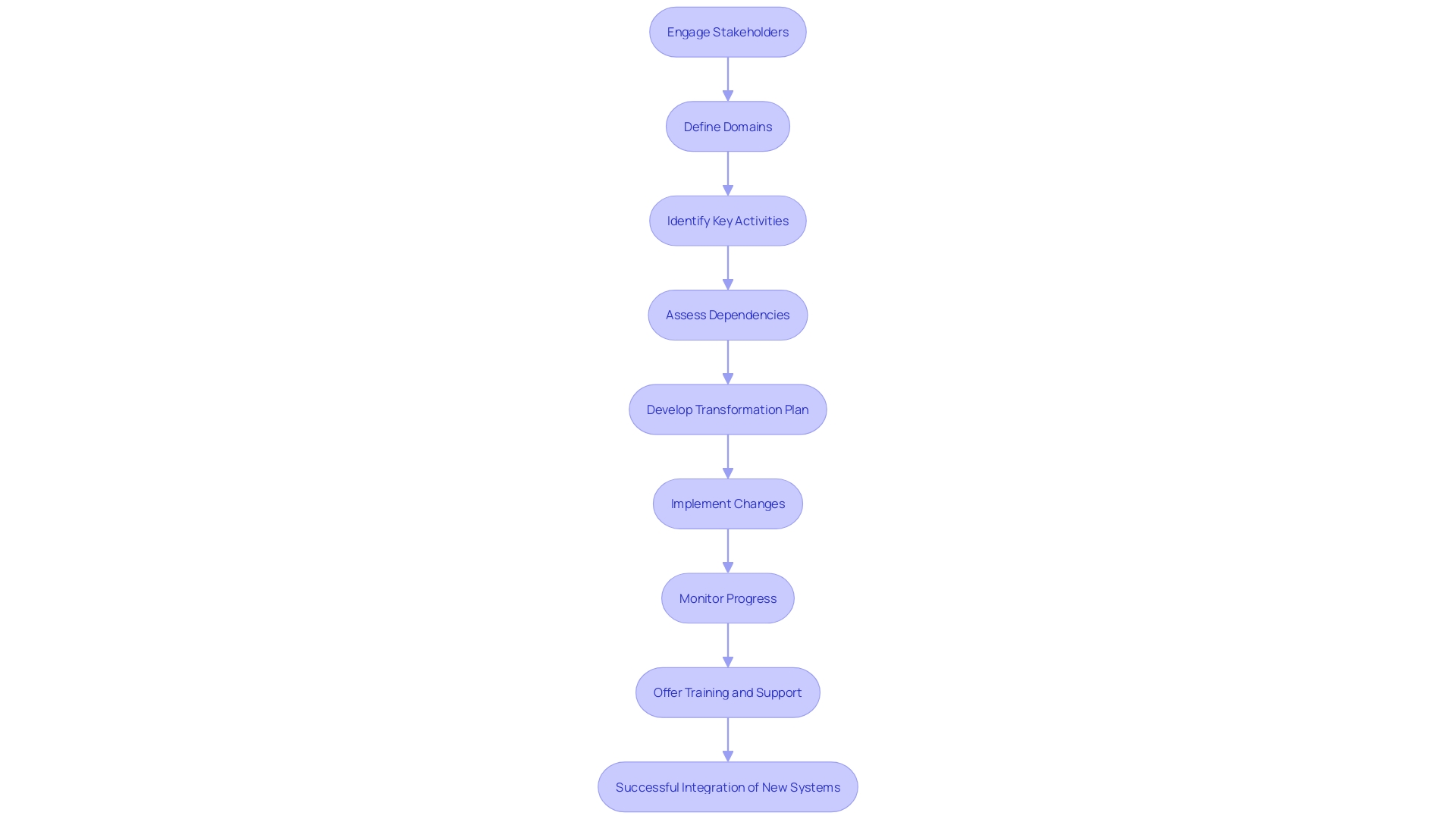
Best Practices for Successful RPA Implementation
To ensure a successful transition to Robotic Process Automation (RPA), it’s crucial to adopt best practices that streamline the implementation and maximize benefits. Begin by focusing on high-impact activities that can greatly gain from automation. A real-world example comes from the NHS, where an initial assessment by the Digital Service Team ensures that requested technologies are secure, appropriate, and compliant. This proactive approach can prevent redundant efforts and uncover existing solutions that might already be in use.
Maintaining strong governance is another key factor. Governance frameworks direct the implementation activities, ensuring alignment with organizational goals and compliance with regulations. According to industry experts, a structured approach to digitization, digitalization, and digital transformation can enhance data capture, analysis, and information dissemination, thereby facilitating smoother transitions.
Clear and consistent communication throughout the implementation process is vital. Engaging stakeholders and keeping them informed helps mitigate resistance to change and fosters a collaborative environment. The founding members of the AI Center of Excellence emphasize the importance of sharing best practices and insights, which can be invaluable during the RPA journey.
By focusing on these best practices—starting small, concentrating on high-impact areas, ensuring robust governance, and maintaining open communication—organizations can navigate the complexities of RPA implementation more effectively and unleash it’s full potential.
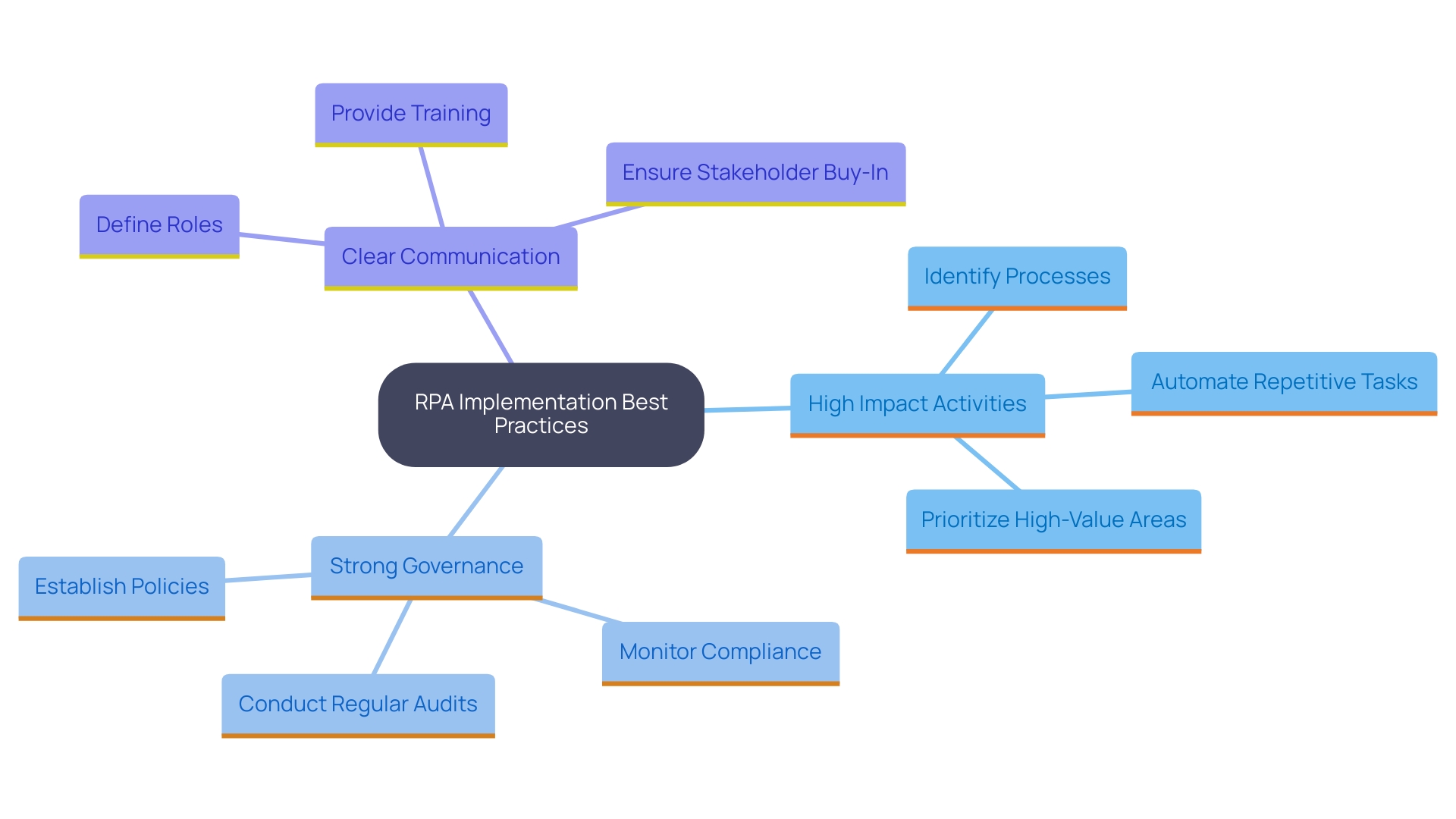
Conclusion
Embracing Robotic Process Automation (RPA) offers organizations a transformative opportunity to enhance operational efficiency and drive significant business benefits. By automating repetitive, rule-based tasks, RPA not only reduces human error but also allows employees to concentrate on higher-value activities. The evidence is clear: businesses that adopt RPA can see substantial returns on investment, improved compliance, and enhanced customer satisfaction.
The journey to successful RPA implementation involves several crucial steps, from assessing processes and defining objectives to selecting the right tools and ensuring seamless integration. Each phase is essential for maximizing the potential of RPA and overcoming common challenges, such as resistance to change and integration complexities. Continuous evaluation and feedback loops play a vital role in refining processes and scaling up RPA initiatives across the organization.
Ultimately, the integration of robust security measures, comprehensive training, and ongoing monitoring will ensure that RPA solutions not only meet regulatory requirements but also foster a culture of innovation and adaptability. By strategically leveraging RPA, organizations can achieve a competitive edge, streamline workflows, and position themselves for long-term success in a rapidly evolving digital landscape.

